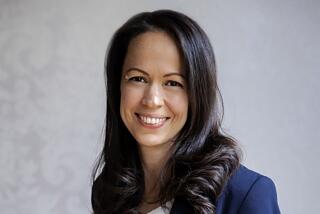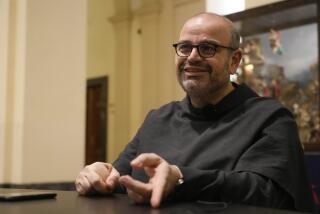World of Technology Has Lost One of the Most Thoughtful in Its Ranks
- Share via
In Silicon Valley, technological breakthroughs sometimes seem to arise spontaneously, a kind of magic.
Actually, nearly all the most important developments start as someone’s deep thoughts.
When Mark Weiser, chief technologist at Xerox Corp.’s Palo Alto Research Center, passed away last week, taken by cancer at age 46, the world of technology lost one of the most thoughtful in its ranks.
Weiser is considered the father of “ubiquitous computing.” He coined the term in 1988, and though ubiquitous computing has yet to arrive, many leading technologists view it as an inevitable development that will change our world profoundly.
“Ubiquitous computing is roughly the opposite of virtual reality,” Weiser wrote. “Where virtual reality puts people inside a computer-generated world, ubiquitous computing forces the computer to live out here in the world with people.”
Weiser envisioned technology fading into the background--the intrusive, endlessly complex machines we call computers giving way to hidden devices designed to do our bidding without cluttering up our lives and stealing our attention.
“He wanted to find a way to shape technology to fit us, rather than expecting us to fit technology,” said John Seely Brown, director and chief scientist of PARC, the birthplace of many of computing’s proudest achievements.
Car computers, Internet-connected hand-held devices and the futuristic wearable computers pioneered by the Massachusetts Institute of Technology’s Media Lab are just the beginning. Weiser foresaw a multitude of programmable microscopic machines embedded in clothing, appliances, walls and furniture, working in concert to sense the environment and change dynamically: Smart Matter.
Spread a can of “smart paint” on your walls and gain the ability to change the color of the room at will. Use another can of smart paint to apply a pair of stereo speakers--sub-woofers and all.
Weiser envisioned a quintessential Xerox application--movable toner, the ink-like substance used in photocopying. “The size of a piece of toner is the same as one of these micro-machines, about 10 to 20 microns,” he said in an interview last fall, theorizing future toner with mechanical “feet” that would move particles around to display an entire book, one page at a time, on a single sheet that you could fold into your pocket.
An ultra-safe Smart Matter car, Weiser said, would actively respond to road conditions and in a collision sense the shape of the object being hit and crumple away from the impact.
No one knows whether such ideas will ultimately prove feasible. But many high-tech leaders say that Weiser’s overall vision will vastly improve the relationship between people and machines.
His interests were broad--from arcane software programming to rock music. He was the drummer for a band called Severe Tire Damage, composed of technologist musicians. The band was the first to perform live on the Internet, with full video and audio, in June 1993 at a PARC performance.
A year later, the Rolling Stones tried to lay claim to that distinction but were quickly corrected by Internet cognoscenti. In the midst of the mini-controversy, Severe Tire Damage got its 15 minutes of fame, recalls band guitarist Russ Haines. Smithsonian magazine pegged Weiser as “rock’s smartest drummer,” Haines said, chuckling. “That was great fun because when we went out drinking we could say, ‘Look, rock’s smartest drummer forgot his drumsticks again.’ ”
That breadth of interests combined with the suddenness of his illness and death meant that Weiser never wrote his big book on the more humanistic side of computation--his great regret, said Brown. And he never had the single-minded drive to form a Valley start-up and become rich and famous.
“His impact was quite widespread if not so loud,” said Michael Dertouzos, director of the MIT Laboratory for Computer Science.
That quiet modesty may have endowed Weiser with something many wealthy and brilliant engineers lack--a view beyond digits and circuits to implications.
“In the Valley, most people are so fascinated by technology that humans never enter the equation,” said Paul Saffo, a director of the Institute for the Future in Menlo Park, Calif. “Mark really lived at the boundary between people and technology and asked deep questions about how we make this technology fit into our lives and do good things and not distract us.”
A few years ago, PARC participated in a ubiquitous-computing experiment that involved using sensor-equipped ID badges to track employees’ movements throughout the day. Press reports described the technology as Orwellian, and though Weiser disagreed, he welcomed the debate.
“No set of principles can take the place of engaging in discussion--pulling, pushing and throwing one’s weight into composing the life and culture we lead and will lead in the future,” he wrote in the technology journal Computer-Mediated Communication. “Engineers like myself are just a part of the dialogue, perhaps the smallest part. . . . The main discussion is the one that happens day to day among all the individuals of our culture as they choose to go along or dissent.”
Weiser seemed intuitively to know what many high priests of technology fail to grasp, to everyone’s peril: Experts, for all their brilliance, rarely have special qualifications for judging the social consequences of technology or for making decisions about the trade-offs or choices technology forces. In a democratic society, those decisions are up to all of us.
A Weiser memorial Web site has been set up at https://www-sul.stanford.edu/weiser.
*
Times staff writer Charles Piller can be reached at [email protected].






